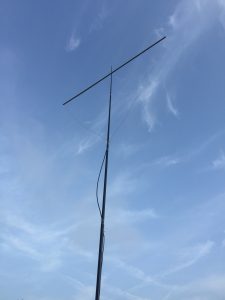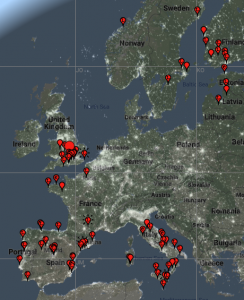This week I put together a simple delta loop antenna for 6m. This is a simple, cheap, lightweight horizontally polarised somewhat-directional antenna. Fantastic for the sporadic E season which is going on right now – especially in a confined space where a beam isn’t practical.
It looks like this:

I made it out of 6m of hookup wire, some 75 ohm coax, 2m of plastic pipe, and a PL259 connector. All of which I found in the garage.
It is hung on a SOTABEAMS fibreglass pole, about 6m above ground level in my case. No guys, just strapped to the washing line with velcro.
Almost immediately after plugging it in, I decoded PV8DX in Brazil on FT8. That was exciting! Even if it was a fluke. Since then I have worked Italy on SSB, and Malta, Estonia, Spain, Italy, Sardinia on FT8. Right now I’m +8dB into Sardinia, so this thing gets out okay!
A quick test on a web SDR shows a 9dB difference between broadside and end-on, so it’s reasonably directional.
A word on matching. A delta loop has a nominal impedence of 100 ohms. To match to 50 ohm coax, this design uses a simple piece of 75 ohm coax as an impedence transformer. This works by taking advantage of the mismatch between 50 and 75 ohm coax. For 6m, a 99cm length is necessary. No other matching or choking seems to be required for this antenna, so it should be fairly low-loss.
The construction details:
- Cut 105cm of 75 ohm coax. Strip 3cm off each end, leaving 99cm intact.
- Cut 2x 3.1m lengths of wire. I used RS 356-713, obsolete, but any will do.
- Join one length of wire to the shield of the coax, join the other length of wire to the centre conductor of the coax.
- Drill a hole just wide enough for the wire at each end of the plastic pipe, through both walls. My two holes were 198.5cm apart from each other.
- Feed each piece of wire through one of the drilled holes. Bring together, strip and twist together the two pieces of wire at the midpoint of the pipe.
- Put a connector on the free end of the 99cm bit of coax.
- Drill a hole through the plastic pipe around 8-10mm, enough to push the second-to-top section of the SOTABEAMS mast a reasonable way through it.
- Connect your antenna to your coax, raise the mast, tune for SWR by chopping out short lengths of wire until the SWR is low at the desired centre frequency. I found perfect resonance (50 ohm resistive, 0 ohm reactive, 1.0:1 SWR) at 50.313MHz, the 6m FT8 frequency, with 598.5cm wire. This bit is much easier with an antenna analyser but can be done with a rig set to lowest power and an SWR meter.
- Finalise and seal the connection between the two pieces of wire.
Finding the perfect length of wire for resonance will depend on the accuracy and quality of the 75 ohm section, and on the velocity factor of the antenna wire, which can vary. The maths predicts that resonance at 50.313MHz should be 5.963m of wire, so 5.985m (22mm difference) is damn close.
I quite fancy making 2m and 4m versions of this. The following table shows scaled measurements for 2m and 4m, based on this successful implementation for 6m.
Band Centre freq Wire length Coax length Boom length
6m 50.313 5985mm 990mm 1985mm
4m 70.200 4290mm 710mm 1423mm
2m 144.300 2087mm 345mm 692mm
Here’s where I’ve been heard over a few hours this evening:

and these are the stations we’ve heard this evening:

If you make one of these, let me know how you get on!


